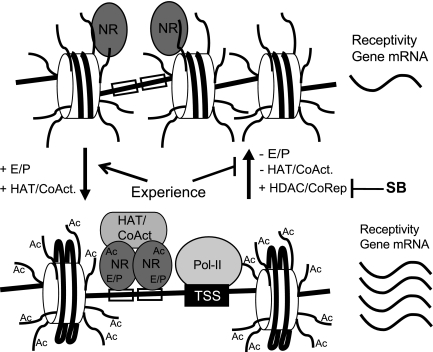Fig. 6.
Model for potential mechanism of estradiol and P signaling and histone deacetylase inhibition on receptivity. In the top panel, nuclear steroid receptors (NR) are not bound to ligand and do not occupy the DNA (straight black lines) promoters of estrogen- and P-responsive genes. In this transcriptionally inactive state, the chromatin is hypoacetylated, the RNA polymerase-II (Pol-II) is not recruited to the transcriptional start site, and the receptivity-promoting gene mRNA is expressed at low levels. In the bottom panel, ligand-activated (E/P) nuclear receptors dimerize and bind to estrogen and P response elements (open boxes), recruit coactivators (CoAct) including HAT to the promoter, cause acetylation (Ac) of histone (cylinders) tails and/or NR (AcNR), and recruit the basal transcription machinery and Pol-II to the transcription start site (TSS) to increase the expression of receptivity-promoting genes. Loss of ligand binding returns the genes to an inactive state in part by HDAC corepressor activity. HDAC inhibitors like SB impede the dynamic removal of acetyl groups leading to hyperacetylation that allows for increased and/or prolonged transcription of genes in the active state.

